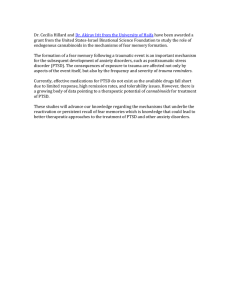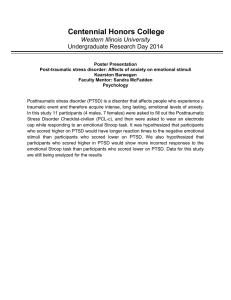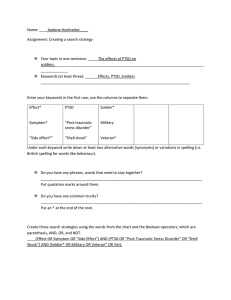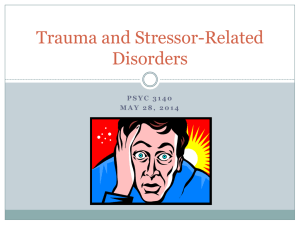Pharmacotherapy for Post-Traumatic Stress Disorder Presented by: Ann Hamer, PharmD, BCPP Date: 01/29/2015
advertisement
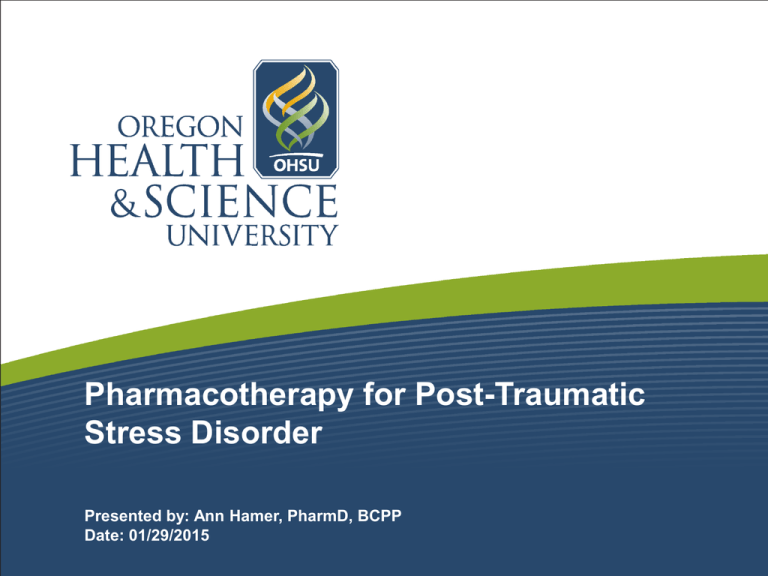
Pharmacotherapy for Post-Traumatic Stress Disorder Presented by: Ann Hamer, PharmD, BCPP Date: 01/29/2015 Disclosures and Learning Objectives Learning Objectives: • Know the two classes of medications most helpful for PTSD • Know how to select a second-line treatment alternative Disclosures: Dr. Ann Hamer has nothing to disclose. PTSD in the Primary Care Setting • Discuss step-wise approach in treatment of PTSD • Gold standard • Indicated medications • Strength of evidence • Second-line treatment recommendations • Topic for next time Pharmacologic Interventions Psychotherapy (CBT) remains the gold standard treatment for PTSD • All of the existing guidelines (6 out of 6) agree that trauma-focused psychological interventions are effective, empirically supported first-line treatments for PTSD • Less agreement among guidelines in regards to pharmacologic interventions. • 50% agree that SSRIs are first-line (VA/DoD, APA, ISTSS) • IOM guidelines found minimal evidence for all pharmacologic treatment options Pharmacologic Interventions General Considerations for Pharmacotherapy: • Main goal is to minimize symptoms rather than cure PTSD • Hyperarousal symptoms (nightmares, etc) are the most likely to respond • Medications should never replace therapy unless it is ineffective or declined • Patient preferences need to be incorporated into shared decision-making because they can influence treatment adherence and therapeutic response http://www.thecarlatreport.com/printpdf/5050 http://www.publichealth.va.gov/docs/vhi/posttraumatic.pdf http://www.nice.org.uk/guidance/cg26/resources/guidance-posttraumatic-stress-disorder-ptsd-pdf Pharmacotherapy: Strength of Evidence Drug Class Drug Alpha Blocker Anticonvulsant Antipsychotic SNRI PTSD Sx Remission Loss of PTSD Dx Prazosin I I I Divalproex I I I Lamotrigine I I I Tiagibine I I I Topiramate M I I Olanzapine I I I Risperidone L I I Desvenlafaxine I I I Duloxetine I I I Venlafaxine M M I Strength of Evidence: M=Moderate; L=Low; I=Insufficient Pharmacotherapy: Strength of Evidence Drug Class Drug PTSD Sx Remission Loss of PTSD Dx SSRI Citalopram I I I Fluoxetine M I I Paroxetine M M I Sertraline M I I TCAs All I I I Other SGAs Bupropion I I I Mirtazapine I I I Nefazodone I I I Trazodone I I I All I I I Benzodiazepines Strength of Evidence: M=Moderate; L=Low; I=Insufficient Pharmacotherapy: Strength of Evidence Outcome Measure Inducing remission Paroxetine X Venlafaxine X Improving depressive symptoms X X Improving functional impairment X X Improving quality of life X Psychological and Pharmacological Treatments for Adults With Posttraumatic Stress Disorder (PTSD). Comparative Effectiveness Review No. 92. AHRQ Publication No. 13-EHC011-EF. Rockville, MD: Agency for Healthcare Research and Quality; April 2013. www.effectivehealthcare.ahrq.gov/reports/final.cfm. Pharmacology for PTSD: Antidepressants Treatment Recommendations • APA and VA recommend SSRIs as first choice when medications are indicated • Sertraline and paroxetine remain the only SSRIs with FDA approval for PTSD • Dose SSRIs the same as for depression Response • Most studies show a modest response (60% response, 40% remission) http://www.thecarlatreport.com/printpdf/5050 http://www.publichealth.va.gov/docs/vhi/posttraumatic.pdf http://www.nice.org.uk/guidance/cg26/resources/guidance-posttraumatic-stress-disorder-ptsd-pdf http://psychiatryonline.org/pb/assets/raw/sitewide/practice_guidelines/guidelines/acutestressdisorderptsd-watch.pdf Pharmacology for PTSD: Other ATDs Studies on other antidepressants are mixed • • • Evidence supports use of venlafaxine NICE recommends mirtazapine, amitriptyline and phenelzine first-line; less evidence supporting use No evidence for use of bupropion Sleep may be least likely to respond to SSRI • Consider adding mirtazapine (low dose), trazodone, or a low dose sedating TCA like amitriptyline/doxepin http://www.thecarlatreport.com/printpdf/5050 http://www.publichealth.va.gov/docs/vhi/posttraumatic.pdf http://www.nice.org.uk/guidance/cg26/resources/guidance-posttraumatic-stress-disorder-ptsd-pdf http://psychiatryonline.org/pb/assets/raw/sitewide/practice_guidelines/guidelines/acutestressdisorderptsd-watch.pdf Pharmacology for PTSD: Antipsychotics Should not be used first-line; should not be used as monotherapy; no studies support use of typicals Sedating atypicals most likely to show benefit • • • Risperidone is the most researched, and may be a helpful adjunct to SSRIs Olanzapine helpful in some studies, esp as adjunct Quetiapine supported, though research is lacking Other medications are better choices as sedatives http://www.thecarlatreport.com/printpdf/5050 http://www.publichealth.va.gov/docs/vhi/posttraumatic.pdf http://psychiatryonline.org/pb/assets/raw/sitewide/practice_guidelines/guidelines/acutestressdisorderptsd-watch.pdf Pharmacology for PTSD: Mood Stabilizers Often shown to be ineffective, especially as monotherapy • Trials showing effectiveness are typically open-label • Notably, valproate (Depakote) no better than placebo. • Topiramate may be helpful for nightmares and flashbacks http://www.thecarlatreport.com/printpdf/5050 http://www.publichealth.va.gov/docs/vhi/posttraumatic.pdf http://psychiatryonline.org/pb/assets/raw/sitewide/practice_guidelines/guidelines/acutestressdisorderptsd-watch.pdf Pharmacology for PTSD: Anti-Adrenergics More helpful in the short term Typically associated with less stigma May help with hypervigilance and activation • Propranolol 10 - 40mg po 3-4x/day • Clonidine 0.1 - 0.3mg po bedtime and PRN • Prazosin 1 - 3mg po bedtime • Guanfacine not supported in studies http://www.thecarlatreport.com/printpdf/5050 http://www.publichealth.va.gov/docs/vhi/posttraumatic.pdf http://psychiatryonline.org/pb/assets/raw/sitewide/practice_guidelines/guidelines/acutestressdisorderptsd-watch.pdf Adrenergic Agents Medication Dosing Adverse Effects Monitoring Propranolol 10 - 40mg po TID-QID Fatigue, dizziness constipation, bradycardia, hypotension, depression, insomnia, weakness, disorientation, nausea, diarrhea, hypersensitivity rxn, purpura, alopecia, impotence BP, HR CYP 2D6 substrate (non-selectively antagonizes beta-1 and beta-2 adrenergic receptors) Clonidine 0.1 - 0.3 po qhs Somnolence, headache Hypotension, abdominal pain Fatigue, nightmares, nausea URI, irritability, throat pain, insomnia, constipation, emotional disturbance, xerostomia, bradycardia, dizziness, temperature elevated, diarrhea, otalgia, sexual dysfxn, withdrawal sx (stimulates alpha-2 adrenergic receptors) Prazosin (antagonizes peripheral alpha-1 adrenergic receptors) 1 - 3mg po qhs Hypotension, first-dose asthenia, dizziness, nausea, palpitations, headache, somnolence, hypotension (orthostatic), impotence, priapism, urinary frequency, dyspnea, arthralgia, myalgia Cr at baseline; vital signs frequently if cardiac conduction disturbance; HR, BP at baseline, after dose increases, then periodically BP Pharmacology for PTSD: Benzodiazepines May be helpful for sleep, BUT… Avoid in active or recent substance abuse • SA in 40% of PTSD (75% if combat-related) Benzos may contribute to emotional numbing • This may interfere with recovery Scant evidence for actual benefit Little evidence for or against buspirone http://www.thecarlatreport.com/printpdf/5050 http://www.publichealth.va.gov/docs/vhi/posttraumatic.pdf General Considerations Define realistic treatment goals: • Reduction in PTSD symptom severity • Suicidal behavior • Substance misuse • Social isolation • Comorbid psychopathology • Global function/quality of life Assess response using validated scales General Considerations When to discontinue treatment: • Effective treatments (treatment goals have been met) should be continued for a significant period of time • Generally >1 year • Those with early robust response may consider shorter duration General Considerations When to discontinue treatment: • Intolerable side effects • Lack of treatment effectiveness • Partial effectiveness • Switch vs. augmentation strategies • Augmentation—difficult to determine if effectiveness is from 2nd agent or from a combination of the two. Only way to determine is to slowly taper first agent. General Considerations First-line • SSRIs Second-line — examine symptoms Symptoms Drug Class Selection Excessively aroused, hyperreactive, dissociative episodes Adrenergic agent Fearful hypervigilant, paranoid, psychotic Atypical antipsychotic Comorbid major depression Other antidepressant (venlafaxine) Labile, impulsive, aggressive Mood stabilizer Psychological and Pharmacological Treatments for Adults With Posttraumatic Stress Disorder (PTSD). Comparative Effectiveness Review No. 92. AHRQ Publication No. 13-EHC011-EF. Rockville, MD: Agency for Healthcare Research and Quality; April 2013. www.effectivehealthcare.ahrq.gov/reports/final.cfm. Summary • • • • • • PTSD occurs in 8.6% of primary care patients DSM-V has shifted PTSD diagnostic criteria to 6 categories (think TRAUMA) Tools like the PC-PTSD and PCL-C accurately detect PTSD in the primary care setting Good treatment avoids retraumatization CBT and EMDR are treatments of choice in PTSD Antidepressants (SSRIs) and anti-adrenergics are the most supported/commonly used medications for PTSD The End! ObsessiveCompulsive Disorder 02/5/15 http://proof.nationalgeographic.com/2014/11/05/musings-corey-arnold-looks-wildlife-straight-in-theeye/?source=photoeditorspicks
